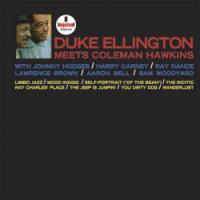Nice collection of music. Two artists in one, this is absolutely awesome! - Carmack Moving and Storage
Duke and Hawk Finally Get Together
Like Elton and Leon, Duke and Coleman were long-time mutual admirers but somehow had never worked together until late in their careers. This session, long in the making, took place on August 28th 1962 and was released the next February.
Ellington brought with him to Van Gelder’s Englewood Cliffs studio his rhythm section of Aaron Bell on bass and Sam Woodyard on drums plus a small group of big-banders: Ray Nance on cornet and violin, Lawrence Brown on trombone and Johnny Hodges and Harry Carney on saxophones.
Like Elton and Leon, Duke and Coleman were long-time mutual admirers but somehow had never worked together until late in their careers. This session, long in the making, took place on August 28th 1962 and was released the next February.
Ellington brought with him to Van Gelder’s Englewood Cliffs studio his rhythm section of Aaron Bell on bass and Sam Woodyard on drums plus a small group of big-banders: Ray Nance on cornet and violin, Lawrence Brown on trombone and Johnny Hodges and Harry Carney on saxophones.
As the notes point out, the Calypso-like opener, “Limbo Jazz” was developed almost spontaneously on the spot as Hawkins busied himself changing a reed. Unbeknownst to all but Ellington, the tape was running and when Hawkins was ready, Duke invited him in and then ended the piece with a single strong gesture.
Next up is a rendering of “Mood Indigo” that’s alone worth the price of admission and features a long, rich Hawkins tenor solo. The rest of the album is equally suave and good-natured and features a series of solo spots that allow Ellington’s trusted sidemen to express themselves fully.
However, even back in 1962 the dance-band swing settings and improvs built upon chord changes were already getting tired. After all, Miles had created Kind of Blue three years earlier and Ornette and others were creating new sounds.
So in 2010 this can sound very sleepy if you don’t get past the backdrop to the brilliance of the individual efforts and especially the tightness of the ensemble playing, with guest Hawkins fitting in seamlessly to a good natured romp through familiar musical territory.
Ellington’s uptempo arrangements like “The Jeep Is Jumpin’” pulse with Lindy Hop energy and locomotive drive that push Hawkins to slice through the chords, while the slower, more elegantly drawn ones like the luxurious “Self-Portrait (Of the Bean)” (the “Bean” being Hawkins) leave plenty of room for the guest to linger within the breathy open spaces.
The album ends memorably with “The Ricitic” spotlighting Nance’s slinky violin weaving in and out of a sensuous Latin rhythm. One can imagine Dan Hicks growing up listening to and being inspired by this gem.
The recording is classic RVG of the early stereo era, with Ellington centered and the other participants spread hard left/right. Reverb is applied sparingly here as opposed to what Van Gelder did to produce the classic “Blue Note sound.”
The hard driving elegance and class expressed here was soon to fade from the American scene replaced by rock on one side of the musical fence and Lawrence Welk on the other.
This double 45rpm set from Analogue Productions sounds remarkably similar to the RVG mastered orange/black original, particularly in terms of the high frequency extension and cleanliness of the cymbals, rim shots and the breathy reediness of Hawkins’ sax—only it's really much better in every way.
The Speakers Corner single 33 1/3 LP ($34.99) was also very good, though a bit less immediate. If you didn’t get to hear the more expensive double 45 ($49.99) you’d be more than happy with it. Not everyone wants to drop the $50 bomb or get up four times so it’s nice having this choice. When you do spend extra for the double 45 you also get the authentic paper on cardboard jacket and the accurate blue typeface inner gatefold artwork, which is both a nice touch and what you should expect to get for fifty clams.
Any of these LPs simply destroy the CD edition, though I haven’t heard the recently released SACD. I played the CD through, using the Playback Designs player as a DAC sourcing the Sooloos music server and I said to myself “This CD doesn’t sound bad,” and it doesn’t, but when I put on the double 45, the improvement was ridiculous!
- Log in or register to post comments




